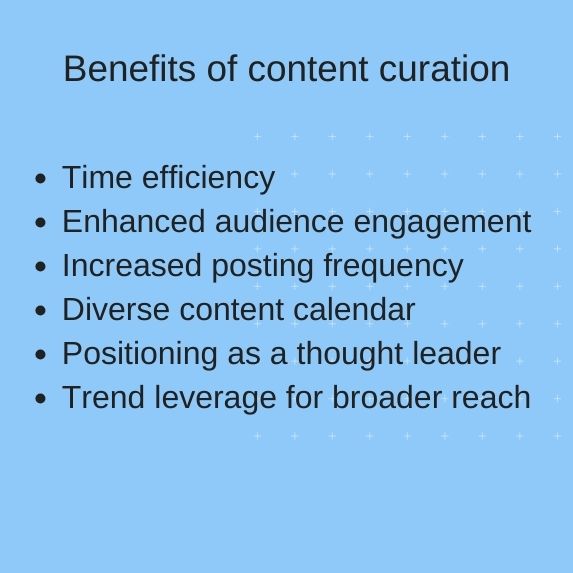Maintaining an active digital strategy requires businesses to create and publish content across seven to eight different channels, ranging from emails to various social media platforms. Each of these channels not only demands its own focused attention but also a strategy that resonates uniquely with its audience.
However, not every business has the resources or capability to generate original content that engages audiences on all these fronts. This is where content curation comes into play, enabling businesses to leverage existing content to maintain their digital presence effectively.
This blog post explores what curated content is and provides a complete guide for businesses looking to include content curation in their marketing strategy.
Table of contents
What is curated content?
Curated content is strategically gathered external content that seamlessly integrates select pieces from reputable and authoritative sources, assembling vital information to captivate and engage audiences across various marketing channels.
The content curation process involves searching for relevant content, gathering sufficient information to organize within topics, and presenting it with your insights to the relevant audience.

Some examples of curated content are blogs that feature expert opinions from various sources, infographics on statistics and other data models, news articles, and curated social media content.
Content curation vs. content creation
Before we go any further, it is essential to understand the difference between content curation and content creation.
The content curation process focuses on gathering, verifying, and organizing information from various sources to present an overall holistic view to your audience. Curated content usually presents different viewpoints or information pieces on the same topic with a unique conclusion or insight.
The content creation process focuses on researching, discovering, and producing original content suitable to your marketing objectives, audience requirements, and brand goals. The content we create delves deeply into a single topic, offering unique insights and first-party data, thereby affirming the brand’s expertise and leadership within the industry.
What are the benefits of content curation?
While original content has many benefits, including higher search engine rankings, building authority in the industry, and attracting high-intent leads, it is equally important to understand the benefits of content curation.

Content curation helps businesses consistently post content across different channels, significantly enhancing the reach of their marketing efforts. Beyond streamlining content distribution, content curation offers a suite of benefits, including
- Time efficiency
- Enhanced audience engagement
- Increased posting frequency
- Diverse content calendar
- Positioning as a thought leader
- Trend leverage for broader reach
Let us explore these benefits in detail.
1. Time efficiency
Curating content from trusted sources helps businesses save time without compromising their content marketing strategy. By not exclusively focusing on the time-consuming content development process, they can devote time to other marketing or business operation activities.
The saved time also helps strengthen your overall strategy by investing in keyword research, competitor analysis, identifying potential opportunities, and more.
2. Enhanced audience engagement
As customers engage more with your content on social media, your engagement rates will naturally increase.
That makes it very important for businesses to post content that sparks conversations and motivates social media users to engage with your business actively.
However, creating original content on industry topics may not always do the trick. For example, a plumbing business does not inherently lend itself to thought-provoking interactive content. However, they can curate content from news stories on plumbing maintenance costs and standards to spark a conversation on their social media account.
3. Increased posting frequency
Whether it is social media content, blogs, or emails, it is essential to post content frequently to stay on top of customer minds. However, the challenge of keeping up with a high-frequency posting schedule can be daunting without resorting to content curation.
By curating relevant and engaging content, companies can enrich their original offerings, keeping their audience captivated and connected to their brand’s message.
4. Diverse content calendar
Let’s take the example of the plumbing business once again. If this business relies solely on self-generated content, its content calendar risks becoming dull and repetitive quickly. Given its expertise in plumbing and related home services, the scope of topics it can cover independently is naturally limited.
On the other hand, by integrating curated content, the business can feature industry news, recent discoveries, opinion pieces, and a variety of other content. This will diversify its content and uplift its approach to the subject matter, exploring it from multiple angles.
5. Positioning as a thought leader
Curated content goes beyond merely gathering information for a content piece. It also offers unique insights, opinions, and perspectives on the overall subject matter. When your business invests in robust content curation processes, it positions the brand as a thought leader, boosting trust in your products and services.
6. Trend leverage for broader reach
Every business dreams of going viral on social media. However, for some, like service businesses and big companies, using memes or jokes doesn’t always attract their audience.
Instead, they can focus on content curation. This means finding and sharing interesting information about hot topics to join in on popular conversations in a way that appeals to their audience.
Develop relevant and innovative content ideas with Birdeye’s generative AI tool
Want to see the impact of Birdeye on your business? Watch the Free Demo Now.
5 content curation best practices
With curated content, you would gather information from third-party sources. Therefore, it is essential to do it right. Here are a few best practices for optimum results from content curation:
- Understand your audience
- Identify relevant content to curate
- Add your opinion
- Credit your sources
- Choose the right mix of creation and curation
Let’s explore these in detail.
1. Understand your audience
Curated content must be relevant, helpful, and engaging to interest your audience. And you can also do it well if you know your audience thoroughly. As with any marketing strategy, begin by analyzing your target audience base to understand:
- Demographic makeup
- Their interests
- Content preferences across social media platforms
- Pain points
This information lets you choose suitable sources, topics, and formats for your curated content pieces.
2. Identify relevant content to curate
The next step is finding what content you want to curate on your channels. This would depend on your target audience, industry standards, marketing goals, and business requirements.
You must also reconcile your overall content marketing strategy so the content curation process blends well with the created content pieces. Ideally, they must reinforce the concepts and knowledge you convey in your original content.
Also, choose highly-established, trustworthy, and popular sources for your content curation process. This will help you deliver high-quality content to your audience.
3. Add your opinion
Customers can read those individual content pieces anywhere, and mostly they will. If you want to gain the audience’s attention and make them view your blog/social media post, there must be something unique.
Including your insights, opinions, or commentary can add perspective to the overall curated content piece. It also provides value to your audience and makes them feel valued as you take the time to tailor the content to their requirements.
4. Credit your sources
Honesty is a good quality in a business. Be upfront with your audience about the curated content piece by including sources, content credits, and links to the original pieces.
This boosts trust in your brand and allows your customers to verify the authenticity of the information.
5. Choose the right mix of created and curated content
Standard practice rules state that businesses must include 40% curated content and 60% original content in their marketing strategy. Customers must see more of your expertise and unique opinions on their pain points, requirements, and product needs.
Content curation sources for maximum impact
Your content curation sources play a vital role in the impact of your curated content. Here is a list of top content curation sources businesses can include in their marketing strategies:
- Newsletters: Marketers and content writers must subscribe to industry newsletters, digital publications, magazines, and blogs to stay updated on current trends. These sources can also help you identify topics to include in your content strategy and present high-quality information to your audience.
- News sites: Local events, essential events in your business location, relevant government regulations, and others can also feature in curated content. Subscribing and following prominent news sites can help you be the first to share important happenings with your audience.
- Social media: Monitoring social media platforms for trending topics, discussions, and breaking news can help you quickly join the conversation and improve your reach. You can use social listening and social curator tools to do this.
- Content curation tools: They help streamline the curation process, discover new topics, curate relevant content, and organize them for easy reference. Leverage these to never miss out on an important topic. Popular content curation tools include Google Alerts, Scoop.it, TrendSpottr, Flipboard, and Curata, etc.
Frequently asked questions on curated content
Businesses should consider curated content as part of their marketing strategy to improve engagement rates, boost interactions with the audience, and position themselves as thought leaders in the industry.
Syndicated content is the owned content you republish across channels, while curated content is content you gather from other channels to repurpose and present to your audience.
Yes, it is legal to curate content if you credit the sources and do not attempt to claim the content as your own.
Generate social media content ideas with Birdeye’s generative AI tools
While content curation makes up 40% of the content calendar, businesses must also ensure that the original content they publish meets customer standards. The expectation of creating original content ideas can be exhausting, especially if you manage multiple social media accounts.
That is why Birdeye Social enables businesses to leverage the built-in generative AI tools to generate social media post ideas, develop content for your channels, and tweak it per each channel’s requirements.
With Birdeye Social, you can enrich your content with hashtags, external links, and stock images. Our bulk posting feature also enables businesses to post to multiple social media accounts in one go.
Explore the leading AI-driven social media management tool now to level up your content creation efforts!

Originally published






![[Feature image] The best AI tools for business in 2025 A complete guide for productivity, content, and growth](https://birdeye.com/blog/wp-content/uploads/Feature-image-The-best-AI-tools-for-business-in-2025-A-complete-guide-for-productivity-content-and-growth-375x195.jpg)

